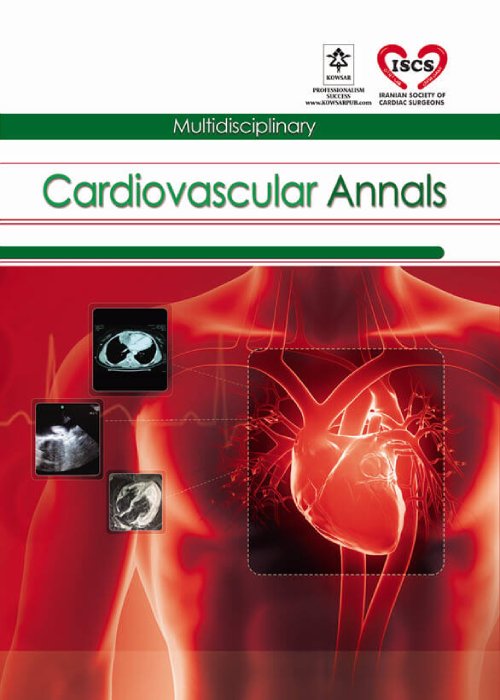فهرست مطالب
Multidisciplinary Cardiovascular Annals
Volume:2 Issue: 4, Aug 2009
- تاریخ انتشار: 1385/11/23
- تعداد عناوین: 8
-
-
Page 2
-
Page 3Background
Postoperative pain remains as a challenging case despite improvement of analgesic techniques. It may also increase the rate of morbidity and even mortality. Local anesthesia may decrease the consumption of opioids and its potential side effects. This study was aimed to show the role of local anesthesia in post-sternotomy pain.
MethodsThis prospective randomized clinical trial includes 40 candidates for elective coronary artery bypass graft (CABG) surgery. Patients with diabetic mellitus and other major co-morbidities were excluded. In group A (20 patiens) Bupivacaine 0.25% was continuously infused into subcutaneous tissue using the ON-Q system (I-flow Corporation, Lake Firest CA, USA) (2ml/h for 72h). Group B patients did not receive local anesthetics. The intensity of pain in was measured using Visual Analogue Scale (0-10). Need for narcotics or other analgesics, hemodynamic and arterial blood gas profiles were also recorded.
-
Page 9Introduction
Coronary artery disease A significant metabolic derangement occurs in the ischaemic-reperfused heart of patients undergoing coronary artery bypass surgery using cold blood cardioplegia. It has been reported that up to one forth of deaths after coronary artery bypass grafting surgery may be caused by Reperfusion injury especially in patients with higher NYHA classes. There are evidences that in adult cardiac operations, a warm cardioplegic reperfusate (hot shot) before removing the aortic cross-clamp improves postbypass myocardial function and metabolic recovery. We randomly assigned 41 consecutive patients undergoing primary, elective CABG into two groups; TWBC Group who received Terminal Warm Blood Cardioplegia just before removing of Aortic cross clamp (n=24) and second group (Control) did not received TWBC (n=17). Among patients in CONTROL group 41% (95% CL: 19-62%) received at least one inotrope, but only 17% (95% CL: 0 - 35%) of patients in TWBC group did so (p = 0.085). Also in respect to EF there was superiority in TWBC group only in patients with low pre operative EF. There was higher rate of spontaneous beating in TWBC group (21 of 24 or 88%) versus Control group (12 of 17 or 70%; P<0.1).
Conclusionit seems prudent to routinely use Terminal Warm Blood Cardioplegia in patients undergoing coronary bypass graft especially in those with reduced ventricular function.
Keywords: Cardioplegia, CABG, Myocardial Protection -
Page 13BackgroundPost-operative bleeding is one of the Challenging issues in cardiacsurgery. The Excessive bleeding and need for transfusion of blood products may increases the patients’ mortality and morbidity. Although use of antifibrinolytics has long been the issue of interest but recently according to some reports of sudden death after use of aprotinin has encountered great limitations. So we decided to find an alternative drug for aprotinin. Methods and Materials: This study was performed as a Double blind Randomized clinical traial. Three hundred patients underwent open heart surgery using CPB to Shahid Rajaee Heart Center. The patients were divided into 3 groups; each containing 100 patients. Group A Amicar (Caproamin), group B (Tranexamic acid) and group C (Control). The mean age was 56.5 yr. (Ranged 16-79). 65.3% were male and 85.7% underwent CABG. Need for blood and blood products transfusion in operating room, ICU & ward, as well ad post-op drainage volume during 6, 12, 24 hours were evaluated. The probable post-op complications including post-op myocardial infarction or CNS, renal complications were also recorded
-
Page 18Introduction
Aorto-pulmonary window is a very rare Malformation which accounts for about 0.15% of all cardiac anomalies. There is no tendency for AP windows to close spontaneously. The natural history of infants with large AP windows is as unfavorable rarely they survive to childhood and those who survive beyond early life have important pulmonary vascular disease (1). The Richardson classification system for aorto-pulmonary window includes simple defects between the ascending aorta and pulmonary trunk (type I), defects extending distally to include the origin of the right main pulmonary artery (type II), and anomalous origin of the right main pulmonary artery from the ascending aorta with no other aorto-pulmonary communication (type III).
-
Page 24We propose to analyse the long-term follow-up in patients older than 65 years of age who received a mechanical valve in the aortic position, using death and prosthetic-related complications as endpoints. From April 1988 to December 1995, 144 consecutive patients 65-75 years of age (mean 67.7±2.5) were enrolled. Total duration of follow-up was 1663 patient-years (median 13.0 years) and was complete for 99% of the patients. Thirty-day mortality was 1.4% (n=2). At the end of the study, 77 patients (53.8%) were alive, with ages ranging from 77 to 91 years (mean 82.1±3.2 years). The overall 5-, 10- and 15-year actuarial survival was 87.4%±3.0, 67.7%±4.3 and 58.5%±4.5, respectively. Freedom from stroke was 93.3±3.1%, 84.6±3.3% and 71.7±4.5%, respectively, after identical periods. Freedom from major bleeding was 97.2±1.1%, 90.4±3.5% and 86.4±4.0%, respectively. Freedom from endocarditis was 95.7±2.3%, 95.0±2.1% and 94.4±2.5%, respectively, and freedom from reoperation was 98.0±1.2%, 97.6±1.3%, 96.9±2.4% and 96.4±2.6%, respectively. Freedom from major valve-related events was 87.7±2.6%, 73.9±3.4% and 61.5±4.6%, respectively. Nearly two-thirds of the patients were alive and free from major adverse valve-related events. Hence, we consider implantation of a mechanical prosthesis in elderly patients safe and appropriate, but the choice must be tailored for each specific patient.Keywords: Aortic valve replacement, Elderly, Mechanical prostheses, Bioprostheses
-
Page 35A 30-year-old woman presented with doxorubicin-induced heart failure. She had been treated due to Ewing’s sarcoma five years ago. Traditional heart failure treatment has been performed but its effect was mostly very limits. We, therefore, decided to perform heart transplantation for her.Keywords: doxorubicin, induced heart failure, Heart transplantation, Ewing's sarcoma
-
Page 38


